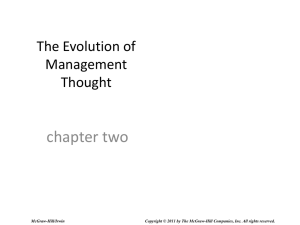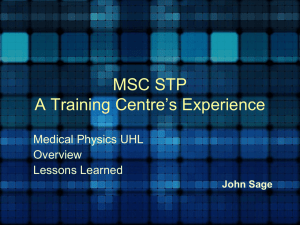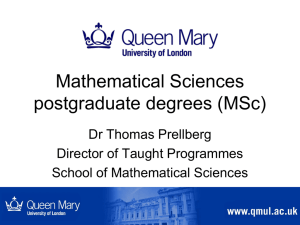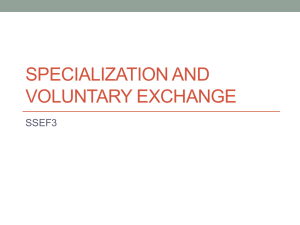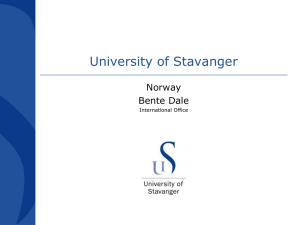Teaching statistics after introducing Bologna system:
advertisement
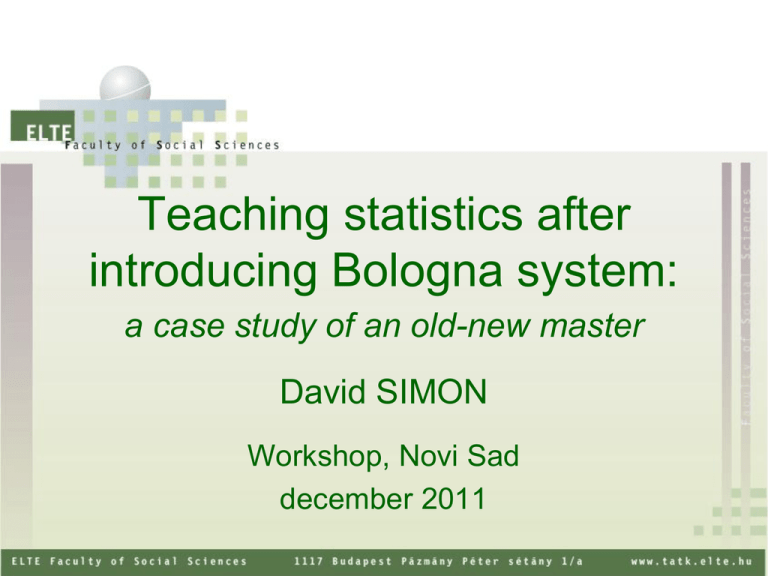
Teaching statistics after introducing Bologna system: a case study of an old-new master David SIMON Workshop, Novi Sad december 2011 Topics • • • • • Introduction Criteria of analysis Sources Bologna system and before Comparing Survey Statistics MSc and Specialization • Some possible solutions • Summary Topics • • • • • Introduction Criteria of analysis Sources Bologna system and before Comparing Survey Statistics MSc and Specialization • Some possible solutions • Summary Introduction • ELTE: largest university of Hungary • Faculty of Social Sciences: – new faculty, previously institute – Social Sciences (BA), Economics, Sociology, Social Policy, Social Work, International Studies, Minority Studies (MA), Health Policy (MA), Cultural Anthropology (MA), Human Ecology (MA), Community and Civil Society Studies (MA), Survey Statistics (MSc) • Department of statistics – Serving other MAs’ and BAs’ needs – Responsible for Survey Statistics MSc Introduction Goals of presentation • Framing introduction of Bologna system • Introducing Survey Statistics MSc and its antecedent specialization in Survey Statistics • Comparing them • Introducing problems • Giving some possible solutions Topics • • • • • Introduction Criteria of analysis Sources Bologna system and before Comparing Survey Statistics MSc and Specialization • Some possible solutions • Summary Criteria of analysis Legal frame Needs of students Needs of business Curricula, teaching methods Knowledge of students Possibilities of University Topics • • • • • Introduction Criteria of analysis Sources Bologna system and before Comparing Survey Statistics MSc and Specialization • Some possible solutions • Summary Sources • Curricula (MSc and Specialization) • Qualitative surveys – students graduated in 2010 – teachers • (legislation) • (personal experience) Topics • • • • • Introduction Criteria of analysis Sources Bologna system and before Comparing Survey Statistics MSc and Specialization • Some possible solutions • Summary Bologna system and before • Two major changes in higher education: – Transition (around 1990) → mass higher education, capitalist business environment – Introduction of Bologna system (2006, 2009) → renewal of curricula (theoretically), end of five year training period Topics • • • • • Introduction Criteria of analysis Sources Bologna system and before Comparing Survey Statistics MSc and Specialization • Some possible solutions • Summary Comparing Survey Statistics MSc and Specialization Circumstances Specialization MSc Starting at every second year every year Length (1)+2 years 2 years Admission no (sociology MA 3rd year, heavy background in statistics) yes (verbal, Social science BA or 30-30 credits social science and statistics) Specialization no theoretical/applied Internship not really 120 h Diplome ‘just’ supplement MSc Comparing Survey Statistics MSc and Specialization Number of students Specialization 10-20 per two years (!) until 2008 MSc Applied Admitted 2009 27 16 2010 63 28 2011 64 37 Comparing Survey Statistics MSc and Specialization Curricula Specialization MSc Mathematical statistics 30 + 240 h 240 (+90) h Applied statistics 180 (+60) h 90 + 180 (+60) h Methodology Market research Social science / history Total (in the general curriculum) 30 h (in the general curriculum) 480 h 90 (+120) h 60 (+60) h 210 h 1050 h Comparing Survey Statistics MSc and Specialization Oppinion of teachers • Specialization was partial training only, students learned other applied statistics and methodological curses • Students on MSc have more heterogeneous background • Students on MSc more business oriented vs. more science oriented students, that were in Specialization • Students may miss some skills previously got from other courses (e.g. social science, multivariate analysis on SPSS) • Sociology MA maybe a competitor for Survey MSc Comparing Survey Statistics MSc and Specialization Oppinion of graduated students • All students would offer to learn here • But 4 of 6 didn’t got what was expected • They expected more mathematical statistics practical knowledge and found hard • They liked the heterogeneity of teachers (mathematicians, social scientists, people from the business, etc.) • They also liked familiarity and flexibility • But missed linkage between theoretical and practical courses • They urged closer relation to market research companies • They would have learnt more statistcal software package Topics • • • • • Introduction Criteria of analysis Sources Bologna system and before Comparing Survey Statistics MSc and Specialization • Some possible solutions • Summary Some possible solutions Heterogeneity of backgound • Tutor system – Two of the best students from the second year of MSc became tutor for first year students, teaching advanced Excel usage and basic SPSS usage in the first half of the first semester • In the second semester students learn to do small simulations illustrating theoretical courses • More talented students (or students with more previous experiences) got special exercises and e-mail consultation – motivation! Some possible solutions More business oriented knowledge • Some courses thought by teachers currently work in the market: eg. research management course, presentation course • On other courses people from market invited to teach one or two occasions: eg. market research course, applied sampling course • We are trying to teach methods (eg. correspondence analysis) and softwares (Excel) that are frequently used on the market Some possible solutions Linkage between theory and practic • On exercise courses theoretical knowledge is practiced on database from market research if possible • On exercise courses of theoretical courses students are practicing on more software that are popular on the market (SPSS, Stata, Excel), not only in R Some possible solutions Finding solutions and problems • We are collecting and comparing course materials to enhance harmony among courses (teachers have freedom of teaching in the frame of curricula) • We are planning to regularly ask students about difficulties, opinions, suggestions • We are planning to ask all graduated students (including from Survey Statistics Specialization) about usage of their knowledge and success Topics • • • • • Introduction Criteria of analysis Sources Bologna system and before Comparing Survey Statistics MSc and Specialization • Some possible solutions • Summary Summary • The shorter the curricula the harder to level knowledge – but talented students can be used for peer training (there other students don’t fear to ask) • Teaching statistics must find its way to business as well especially in circumstances of economic hardness (e.g. high unemployment) – teachers from the market (eg. ex students) can help a lot (and maybe cheap) • A curriculum never can be finished – it worth to make survey among students and even teachers Thank you for your attention! dr.david.simon@gmail.com
